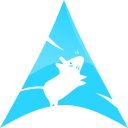-
Posts
5150 -
Joined
-
Last visited
Content Type
Profiles
Forums
Events
Everything posted by scarecrow
-

Am I messing up the system?[Solved]
scarecrow replied to M_R's topic in Command Line, Kernel and Programming
The regular ways to run programs which are outside the system paths are two: 1. Creating a helpfolder (e.g. /opt/progs), linking the programs in there and finally adding /opt/progs to the system PATH 2. Creating aliases to the user's ~.bashrc file. These are user-specific, of course. -
http://www.verisign.com/support/roots.html Download the certificate, and then add it (via the advanced settings tab) to the list of the trusted certificates.
-
You're probably using an old mirror? I can find this package. e.g. ftp://ftp.ntua.gr/pub/linux/mandrake/official/2010.1/i586/media/contrib/release/ruby1.9-1.9.1.p378-3mdv2010.1.i586.rpm
-
"rpm -Uvh *.rpm --force" is defintely not a magic spell. It's an extremely bad practice, which is guaranteed to break your system. NEVER, EVER install rpm's or similar stuff from sources outside your system's PMS. You will regret it, promised.
-
This isn't a terribly active forum for the last four or five months, for sure.
-

Crond doesn't seem to be working
scarecrow replied to krisbee2000's topic in Command Line, Kernel and Programming
Maybe a stupid question: Did you make your scripts executable? (chmod +x) and given them the right permissions? -
Nice! :)
-
You can touch the config files directly, but Fedora used to have a GUI tool as well. yum install switchdesk-gui and then you can use it to choose between kdm, gdm, lxdm or probably another login manager. Or, alternatively: yum install system-switch-displaymanager and then from root console system-switch-displaymanager kdm Or, finally, always as root: nano /etc/sysconfig/desktop add there two lines: DESKTOP="KDE" DISPLAYMANAGER="KDE"
-
Most likely caused by a plugin, it could be java, acrobat reader, or many other things. Try disabling the Thunderbird/Firefox plugins one by one, to find which is causing the crash.
-
systemsettings --- startup and shutdown --- session management Tick "on Login" the Restore Previous Session option.
-
Run as root sane-find-scanner If the scanner is recognized, then it's either a missing backend (you may have to install hplip to get it), or a permissions issue.
-
Delete xorg.conf completely. 2010.1 is evdev managed, and xorg.conf is not needed, unless you use the proprietary nvidia or ATi driver (the latter does not work anymore with old ATi cards). Does your KDE session work OK when starting in "failsafe" mode?
-
If you are using the qtcurve themes in both KDE and GTK applications, then you must remove gtk-qt-engine. They don't play nice together. I can't tell if qtcurve is better than oxygen for both KDE and gtk+ with gtk-qt-engine. Both have advantages, and disadvantages. I use qtcurve myself, because it's much more customizable.
-
What about dropping the disfunctional Mandriva draknetcenter, and using wicd or NetworkManager instead?
-
It's the default sound server in Ubuntu, and it's working sometimes. Ain't that enough for you? :P
-
It seems like a Mandriva 2010 respin, which is available exclusively via filesharing channels. I don't enjoy the idea using such stuff. At all.
-
It's quite likely that the modules needed for parallel port printer aren't loaded. Load manually lp, parport and parport_pc modules (in that particular order),restart cups and then try again. If it succeeds then you can preload these modules at system start.
-
It should be a BIOS bug. The keyboard should be visible right away, and more than that PS2 devices aren't supposed to be hotpluggable. Rather the opposite: unplugging a PS2 device while the PC is on is supposed to be potentially harmful.
-
What kind of partition tables are set on the two drives you want to stripe? I think it's better to cfdisk one of the two drives (single primary partition), and then carbon copy its partition table to the second drive: # sfdisk -d /dev/sda > table # sfdisk /dev/sdb < table
-

Need help with mount, fstab and mtab [solved]
scarecrow replied to M_R's topic in Command Line, Kernel and Programming
Permissions issue, maybe? # ls -l /etc/fstab -

Connecting to Windows printer with Samba [solved]
scarecrow replied to danny1262's topic in Networking
Just get sure avahi and cups daemons are running, and open your web browser at http://localhost:631 According to the printer model, you may have to install ghostscript, hplip, gutenprint, foomatic... or some other configuration tool. -
UUID=F2EAD096EAD05905 /mnt/windows/ ntfs-3g user,defaults 0 1 should be enough to get rid of any annoying messages. You don't have to define locale, unless the ntfs filesystem locale is different than the default one of your system.
-
Actually this ***can*** be a symptom of the Mandriva installation. The installer was using cfdisk backend for partitioning, and it is well known that cfdisk has certain problem aligning partitions correctly on large disks with GUID partition tables, or modern SSD disks. A safer choice (till diskdrake switches to parted as its backend) is preformatting the disk using gparted liveCD, and then setting just the mount points during installation.
-
You are not allowed to access the camera /usb storage device due (most probably) to permissions. First get sure you have the package "dosfstools" installed (necessary in old system to access FAT32 partitions) and that the user is alloed to mount removable devices. Can you open the camera as root? ( "kdesu konqueror" and then open the camera from the root konqueror instance ) And yes, AFAIK 2010.1 is still the latest, but upgrading from one version of Mandriva to a newer is not a trivial task. In general, backing upo your user's data and perforimng a fresh installation is the preferred method for Mandriva, as well as any Linux distro which is not following a "rolling" release cycle..
-
Most likely you need a newer version of libgphoto2, which will allow digikam to access the camera as PTP device- but since 2008.1 is older than the Great Pyramid, this may not be feasible. But you can always access the camera as a mass storage device.

